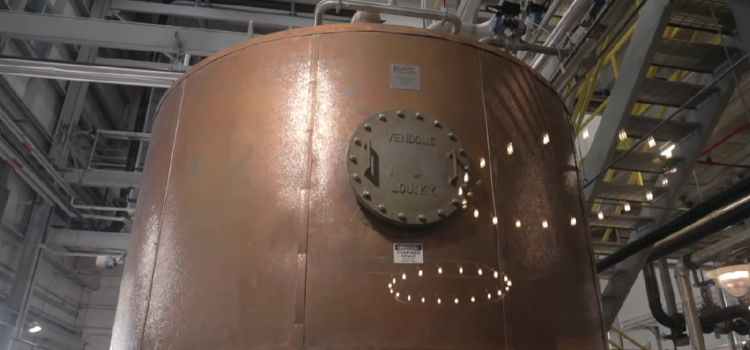Last Updated on February 23, 2024 by Lydia Martin
There are several bourbon choices in the market today, and two of the most popular ones are Buffalo Trace and Bulleit bourbon.
Both bourbons have established a great reputation in the whiskey world, but which do you think is better when compared?
Let’s discover the key differences between these two fine bourbons with our in-depth Buffalo Trace vs Bulleit bourbon review.
Table of Contents
ToggleBuffalo Trace & Bulleit Bourbon Comparison

Both Buffalo Trace and Bulleit bourbon have distinct origins and amazing tasting notes. They share many similarities, like their alcohol content and alcohol type.
But while both have remarkable tasting notes, you can identify their differences in their profiles.
Buffalo Trace is slightly spicy, sweet, and has a wide range of other flavors that play on your palate. On the other hand, Bulleit bourbon has a buttery mouthfeel with hints of spices, vanilla, dried fruit, and butterscotch.
These differences could be attributed to their differences in grain recipe, distillery, and whiskey-making process.
Key Difference

History
Buffalo Trace was named after the ancient mighty buffalo that carved its path along the Kentucky river, where you can find the distillery. It was released in 1999, and the distillery has been known to produce the finest bourbons since 1773.
The first original batch of Bulleit bourbon came from Augustus Bulleit in 1830. But it was 1987 when Thomas Bulleit tried to revive the recipe, and it became the Bulleit bourbon we all enjoy up to this day.
Thomas decided to open Bulleit Distilling Company to pay homage to the unique blend of their family recipe.
Distillation & Production Process

Buffalo Trace bourbon has used the same recipe for over 200 years. Each grain is cooked at a specific temperature before it undergoes fermentation.
After fermentation, it will undergo double distillation and maturation in the middle floors of their warehouse for great temperature fluctuations. But is Buffalo Trace wheated bourbon?
On the other hand, Bulleit was inspired by an old family recipe dating back to 1830.
The distillery uses high-quality grains and pure limestone filtered water; the mash is fermented, distilled, and aged in new charred oak barrels.
Maturation
Bulleit bourbon is aged for six years, while Buffalo Trace is aged for at least seven to nine years.
Both bourbon whiskeys are labeled Kentucky straight bourbon whiskey, so they should be aged in new charred oak barrels for a minimum of two years [1].
However, since Buffalo Trace is aged longer in wood barrels than Bulleit bourbon whiskey, it is more mellow and can be referred to as a deep amber whiskey.
Read: Our Favorite Bulleit Bourbons
Mash Bill
Buffalo Trace uses the mash bill number one, low rye grain recipe, consisting of less than 10% rye, at least 51% corn, and malted barley.
On the other hand, Bulleit bourbon is a high rye bourbon whiskey that contains 68% corn, 4% malted barley, and 28% rye.
Bulleit bourbon contains high rye, spicier than Buffalo Trace and smoother than Bulleit rye whiskey.
However, not all whiskey lovers prefer a well-rounded bourbon like Bulleit and go with the pleasantly sweet and spicy notes of Buffalo Trace.
Age Statement & Alcohol Content
Both spirits do not bear an age statement because the age statement is voluntary on whiskeys with a blend older than four years.
However, Buffalo Trace bourbon is aged longer than Bulleit. According to some reviews, Buffalo Trace is older by at least 2 years than Bulleit.
The two brands contain 90 alcohol proof (45% ABV), but since Bulleit contains high rye content, it tends to be more spicy and bold.
Read: Can You Buy Buffalo Trace At Costco?
Distillery & Ownership

Bulleit was previously a sourced whiskey and did not own a distillery until recently [2]. However, since Diageo acquired the brand, the distillery opened and produced American whiskey varieties on site.
Sazerac Company owns Buffalo Trace and is distilled in Buffalo Trace Distillery (formerly George T. Stagg Distillery in 1904).
Moreover, the Buffalo Trace Distillery is home to brands like Eagle Rare, Sazerac Rye, and Benchmark Small Batch.
Read: Buffalo Trace Bourbon vs Wild Turkey 101
Tasting Notes

Buffalo Trace Bourbon
- Nose: Baking spice, toasted oak, vanilla, fruity sweetness, candied fruit, caramel, brandy pudding
- Palate: Oak, caramel, ripe fruit, vanilla, baking spices, brown sugar, dark fruit, white pepper, and cinnamon
- Color: Deep amber/ Reddish copper
- Finish: Medium, oak, vanilla, slightly spicy and sweet
Bulleit Bourbon
- Nose: Nutmeg, cinnamon, almond, clove, spicy toffee pudding, vanilla, and caramel
- Palate: Rye spice, nuts, dried fruit, toffee caramel, wood, vanilla, maple syrup, and slight citrus
- Color: Light amber
- Finish: Long, spicy, sweet, bold with hints of oak
Price Point & Value

Price point and value is another close round for both brands because Buffalo Trace and Bulleit Bourbon costs have roughly a $2 difference.
A bottle of Bulleit bourbon has a bold and rich flavor, and you can score it at roughly $32.99.
However, the complex aroma and smooth finish of Buffalo Trace may cost you around $34.99 per 750 ml bottle. But why is Buffalo Trace difficult to find?
Bulleit Bourbon & Buffalo Trace Common Prices
| Bourbon | Size | Alcohol Proof | Average Price |
| Buffalo Trace Bourbon | 375 ml | 45% | Around $19.25 |
| 750 ml | Around $34.99 | ||
| Bulleit Bourbon | 750 ml | 45% | Around $32.99 |
| 1 L | Around $42.99 |
*Average prices are based on Drizly online. Prices may vary in local liquor shops.
FAQs Related to Buffalo Trace vs Bulleit Bourbon
Which bourbon gets you drunk faster, Bulleit or Buffalo Trace?
Buffalo Trace can get you drunk faster than Bulleit. While both whiskeys contain the same alcohol content, the flavor profile of Buffalo Trace is easier to drink than Bulleit bourbon. There’s a high chance that you will consume it in large amounts.
Which is spicier, Buffalo Trace or Bulleit bourbon?
Bulleit bourbon is spicier than Buffalo Trace. It is because Bulleit contains a high amount of rye, but not as high as Bulleit rye whiskey. The rye content gives a bold and spicy flavor that can be new to your taste buds.
Which distillery produces Buffalo Trace and Bulleit Bourbon?
Buffalo Trace is produced by Buffalo Trace Distillery in Frankfort, Kentucky, while Bulleit Bourbon is produced by the Bulleit Distilling Co., which is part of Diageo, at various distilleries including Four Roses and the Bulleit Distillery in Shelbyville, Kentucky.
What is the mash bill for Buffalo Trace and Bulleit Bourbon?
Buffalo Trace uses a mash bill containing corn, rye, and malted barley, whereas Bulleit Bourbon’s mash bill is higher in rye content, giving it a spicier flavor profile.
How do the flavor profiles of Buffalo Trace and Bulleit Bourbon differ?
Buffalo Trace typically offers a balanced flavor profile with notes of caramel, vanilla, and oak, while Bulleit Bourbon tends to have a spicier profile with prominent rye characteristics and hints of fruitiness.
Are there any notable differences in aging between Buffalo Trace and Bulleit Bourbon?
While both bourbons are aged in new charred oak barrels, the aging periods may differ between the two brands, potentially contributing to variations in flavor and maturity.
Which brand is more widely available, Buffalo Trace or Bulleit Bourbon?
Buffalo Trace is generally more widely available than Bulleit Bourbon, which may vary in availability depending on the region and distribution channels.
Final Verdict
Buffalo Trace gets the upper hand in the Buffalo Trace vs Bulleit bourbon Head-to-Head Battle. The flavor profile, maturation process, and grain ratio of Buffalo Trace have better value than the Bulleit brand.
Buffalo Trace is a versatile and independent spirit, so you can drink it neat, on the rocks, or as a cocktail.
On the other hand, Bulleit makes a good mixer because its spicy notes can elevate the taste of the cocktail.
References:
















